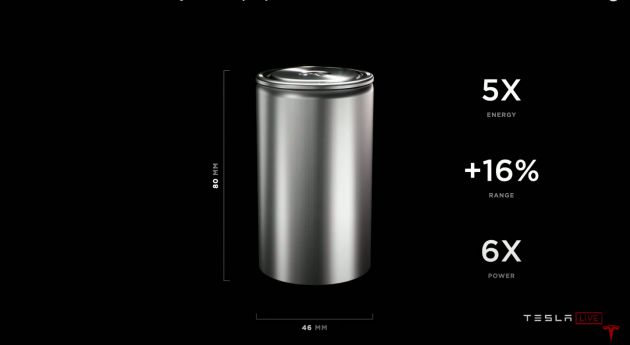Tesla introduces tabless battery cell design – gains of 5x energy, 6x power for 16% improvement in EV range
American electric vehicle maker Tesla unveiled its tabless 4680 battery cell design at its Battery Day event, featuring a new cell that is 80 mm tall and 46 mm in diameter, and promises five times the energy density and six times the power, in order to yield a 16% increase in battery range for electric vehicles.
The manufacturer is about to begin manufacturing the new battery cells at its pilot 10-gigawatt manufacturing plant in Fremont, Tesla SVP of powertrain and energy engineering Drew Baglino said. The new cell manufacturing system isn’t actually in action yet, though it is ‘close to working’ at the pilot plant level, CEO Elon Musk said.
There are three main components that make up a traditional battery; the anode, the cathode and the separator. In addition to the main battery structure, tabs enable energy to be transferred from the cell to an external source.


In large-format lithium-ion cells, there is a ‘foil-to-tab’ weld to collect the foils and join them to the tab. Lithium ions flow from the anode to the cathode through the separator to discharge and charge the battery. The flow process has been the same for batteries for decades, and developments have been mostly in updates to the science of materials and changes to the size of the battery, notes Tech Crunch.
Those changes to size in order to increase power and energy density come with thermal issues, said Baglino. “This was the challenge that our team set its sights on to overcome. We came up with this tabless architecture that removes the thermal problem from the equation, that allows us to go to the absolute lowest cost form factor and the simplest manufacturing process,” he said.
The existing foils were laser-patterned, and enabled dozens of connections into the active material through a singled spiral, and the new design means simplified manufacturing, fewer parts and a shorter electrical path, which is how Tesla manages to achieve the thermal benefits it claims, said Baglino.
In other words, though these are physically larger cells, they manage to keep temperatures comparable to smaller cells, and are able to cram more power into a given physical volume.
Not only does Tesla’s battery development bring gains in terms of energy density, it will also enable the carmaker to form part of the car’s structure, which eliminates the need for conventional structural reinforcements in Tesla bodyshells.
This appears to be inspired by the evolution of the aircraft wing, which in its early years contained the aircraft’s fuel tanks within the wings, but was otherwise a separate part from the rest of the wing assembly which had its own support structure. This then evolved to integrate the fuel storage as part of the wing’s structure, and enabled greater fuel capacity as a result.
In the case of the upcoming Tesla battery pack design, the battery shell casings serve to stiffen the vehicle floor by connecting the upper and lower layers of the floorpan. Because the battery cells can be located closer to the centre of the vehicle, this does away with the need for additional structural reinforcements, thus improving volumetric efficiency, as well as centralising mass for improved handling.
Having the battery cells more centralised also improves crash safety as they are further away from side impacts. With what Tesla calls a ‘revolution in body and battery engineering’, this results in a 10% overall mass reduction, a potential 14% increase in range and 370 fewer parts compared to existing construction methods.
From the new battery cell design that enables greater power and energy density to an improved battery pack design that contributes a better vehicle structure, the ongoing developments mean that Tesla are confident that in the long term, it “can design and manufacture a compelling $25,000 (RM104,177) electric vehicle” in around three years, said CEO Musk, who added that it will be “also fully autonomous.”
The post Tesla introduces tabless battery cell design – gains of 5x energy, 6x power for 16% improvement in EV range appeared first on Paul Tan's Automotive News.
from Paul Tan's Automotive News
Read The Rest:paultan...











































Post a Comment